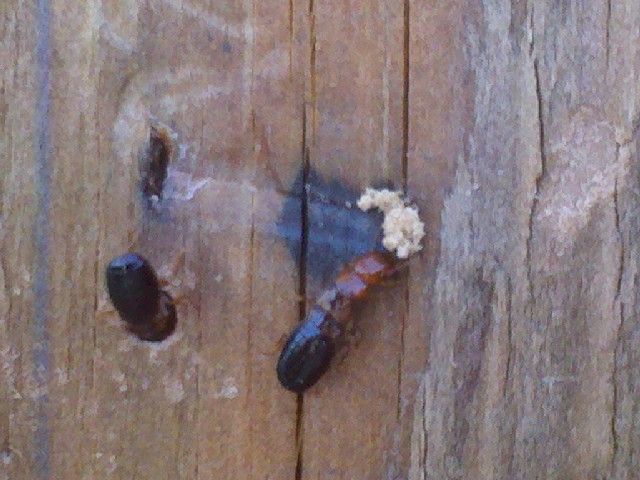
How Can We Stop Termites?
Outside maintenance and sanitation play a crucial role in termite prevention.
Drywood termites often enter homes through joints where different pieces of wood meet. Ensuring these joints are watertight by applying caulking and paint can be helpful. Pay close attention to the early stages of infestation, particularly in areas such as fascia, siding, trim, and rafter tails.
Wooden fences are more susceptible to termite infestations compared to your home due to constant exposure to the environment. It's important to inspect your fence annually and tap the wood to check for hollow sounds. Avoid connecting the fence directly to your home, or use flashing to create a separation. Also, refrain from attaching wooden trellises to exterior walls.
Address any fungus (dry rot) infections as soon as signs of damage appear. Dry rot softens the wood fibers, making it easier for termites to gain access. Termites thrive in controlled environments, so ventilating crawl spaces and attics to reduce humidity is beneficial.
Subterranean termites typically enter through cracks in the foundation, plumbing and electrical entry points, as well as areas where earth contacts wood. Remove old tree stumps and wood debris from around your structure and trim dense greenery away from the foundation. Avoid stacking or burying wood debris near your home. If you store firewood outside, elevate it off the ground.
It's recommended to maintain a six-inch gap between wood siding, stucco, foam board, and the ground. Seal any cracks or holes in your home's foundation to eliminate potential access points for termites. Grade the soil appropriately to ensure water, including air conditioning condensate, drains away from the foundations.
When constructing decks or patios, use treated lumber in sensitive areas. Building code requirements dictate that substructures less than 18 inches off the ground or 48 inches attached to masonry should be treated.
By implementing these preventive measures, you can significantly reduce the risk of termites infesting your home.
When it comes to the interior of your home, sanitation and maintenance are crucial in preventing issues related to pests.
Moisture is a common culprit that attracts various problems such as dry rot, termites, rodents, and more. Plumbing leaks, roof leaks, and even condensation from windows can contribute to excess moisture. By addressing and eliminating the source of moisture, you can effectively minimize the risk of these issues. Remember, it is generally easier to eliminate a water source than a food source for pests.
We highly recommend scheduling a comprehensive home inspection every three to five years to check for the presence of wood-destroying organisms. This proactive approach helps identify any potential infestations or damages caused by pests, allowing for timely intervention and preventive measures.
By maintaining a sanitary and well-maintained interior environment, paying attention to moisture control, and scheduling regular inspections, you can protect your home from the damaging effects of pests and ensure a healthier living space.
Drywood termites often enter homes through joints where different pieces of wood meet. Ensuring these joints are watertight by applying caulking and paint can be helpful. Pay close attention to the early stages of infestation, particularly in areas such as fascia, siding, trim, and rafter tails.
Wooden fences are more susceptible to termite infestations compared to your home due to constant exposure to the environment. It's important to inspect your fence annually and tap the wood to check for hollow sounds. Avoid connecting the fence directly to your home, or use flashing to create a separation. Also, refrain from attaching wooden trellises to exterior walls.
Address any fungus (dry rot) infections as soon as signs of damage appear. Dry rot softens the wood fibers, making it easier for termites to gain access. Termites thrive in controlled environments, so ventilating crawl spaces and attics to reduce humidity is beneficial.
Subterranean termites typically enter through cracks in the foundation, plumbing and electrical entry points, as well as areas where earth contacts wood. Remove old tree stumps and wood debris from around your structure and trim dense greenery away from the foundation. Avoid stacking or burying wood debris near your home. If you store firewood outside, elevate it off the ground.
It's recommended to maintain a six-inch gap between wood siding, stucco, foam board, and the ground. Seal any cracks or holes in your home's foundation to eliminate potential access points for termites. Grade the soil appropriately to ensure water, including air conditioning condensate, drains away from the foundations.
When constructing decks or patios, use treated lumber in sensitive areas. Building code requirements dictate that substructures less than 18 inches off the ground or 48 inches attached to masonry should be treated.
By implementing these preventive measures, you can significantly reduce the risk of termites infesting your home.
When it comes to the interior of your home, sanitation and maintenance are crucial in preventing issues related to pests.
Moisture is a common culprit that attracts various problems such as dry rot, termites, rodents, and more. Plumbing leaks, roof leaks, and even condensation from windows can contribute to excess moisture. By addressing and eliminating the source of moisture, you can effectively minimize the risk of these issues. Remember, it is generally easier to eliminate a water source than a food source for pests.
We highly recommend scheduling a comprehensive home inspection every three to five years to check for the presence of wood-destroying organisms. This proactive approach helps identify any potential infestations or damages caused by pests, allowing for timely intervention and preventive measures.
By maintaining a sanitary and well-maintained interior environment, paying attention to moisture control, and scheduling regular inspections, you can protect your home from the damaging effects of pests and ensure a healthier living space.
